|
Writing.Photography/Amy Chang
Location/Background
At one end of the express way #68 from west to east of this island, the road to this subject village is the main way to a series sightseeing spots, such as Wufeng and Kuanwu in the mountains. Name of this village is Ruan Qiao 軟橋 (Soft Bridge in English), is an amazing village in north Taiwan, its administrative district belongs to Zhudong which is known of the gateway to DaBa Mountain, part of the great Shei-Pa National Park, one of the eight national parks in Taiwan.
But why is “Ruan Qiao”? Mr. Song-Ju, Peng 彭松舉 (short as S. J. hereinafter), the Chairperson of the Ruan Qiao Community Development Association, is the administrative head of Ruan Qiao as well, explained that as early as in Qing dynasty, the Han (a tribe of Chinese) came to this place for cultivation. The main stream Shang Pin swelled to flood over the roads, thus the local residents managed to build up a bridge by Yellow Rotang Palm. When passing by, steps shook the bridge which bridge started to sway, then the name of “Ruan Qiao”. Though the bridge has no longer existed, the village Ruan Qiao is now proud of another characteristic of paintings.
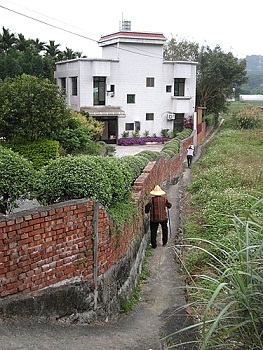 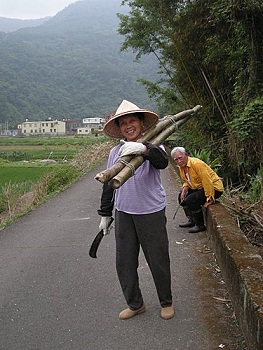
Above: the quiet and hospitality village – Ruan Qiao
Discover the rainbow colors
Driving along on county road #122 after express way #68, we can see the cheerful rice fields, vegetable fields, wild plants, … all are in green. Other than those green colors, the small, old style houses along the road can only in dark grey and the mottled brick colors that don’t surprise you. However, when approaching this special village, suddenly some bright colors catch your eyes, you see paintings on the house walls of animals, human beings, plants, interesting god icons….., all appear to be vivid. Then you start to ask, where am I? The answer is Ruan Qiao!
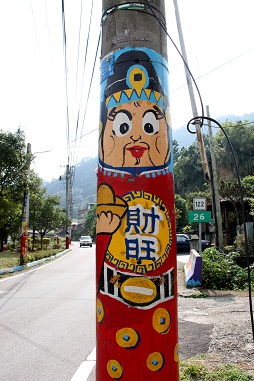 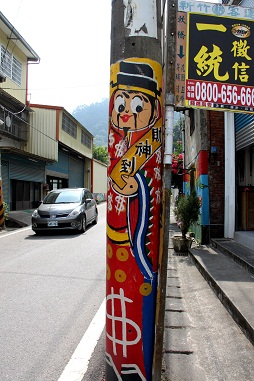
Above: the icon of wealth gods on the electricity poles
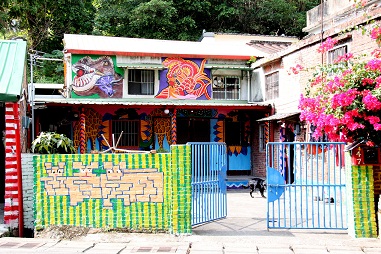
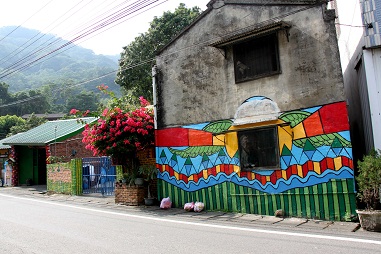
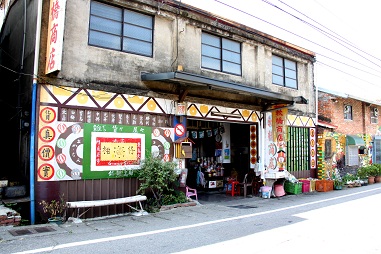
Above: this grocery store is the tourist information center of this village
S. J. said, “The painting is from an idea to maintain the environment to be clean to eliminate the small black mosquito (Forcipomyia taiwana)”. He asked the residents to clean up mosses on the foot of the house walls, and invited the paintings.
All those paintings were done by Zun-Xian, Wu 吳尊賢 (short as Z. X. hereinafter), a son-in-law of Ruan Qiao. His wife Mei-Ai, Fan 范美愛 said, “My husband neither majored in arts in school, nor works as professional painter before Ruan Qiao. Ruan Qiao was his first trial in painting.” “He started to paint almost 3 years ago. The first painting was on a wall in front of the temple of “God of Earth”. Most residents like it that encouraged more creations to go. Now the paintings have already extended to be 1 km long along the main road.”
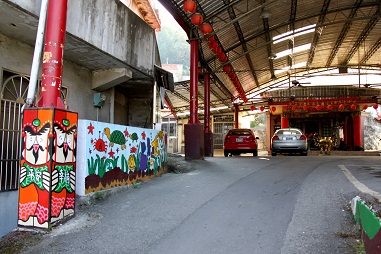
Above: painting on the left is the first trial by Z. X. Wu in front of the temple
Z. X. paints only on weekend when not goes on duty. He also painted his father-in-law’s house located on an upper land away from the main road. The painting on his father-in-law’s house appeared to be more complicated.
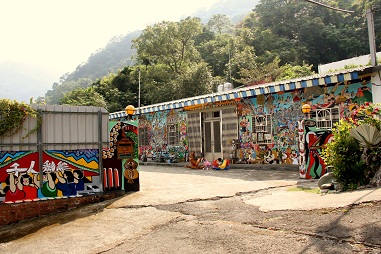
Above: gate of the house of Wu’s father-in-law
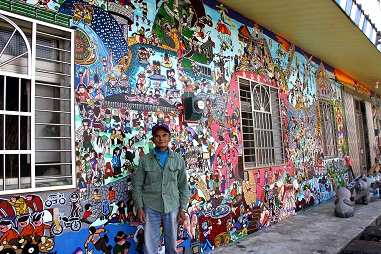
Above: Wu’s father-in-law and his house
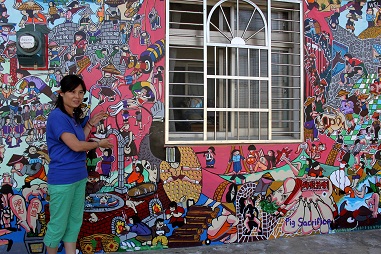
Above: Wu’s wife is introducing her husband’s paintings
Subjects of the painting focus on local customs, the celebration for the harvests, Z. X.’s observation of life, such as the difficulties of living in early days as detail as no CPR that people die in drowned… etc. All are very close to the living, thus are welcomed by the residents. Most residents willingly offered their house for painting.
Except house walls, in public area, walls wear on paintings too, some are with interesting Hakka languages. One on the washing area is a good example which says a little girl wants to visit her grandaunt, she dressed up and has been waiting for her parents’ approval for 2 to 3 days.
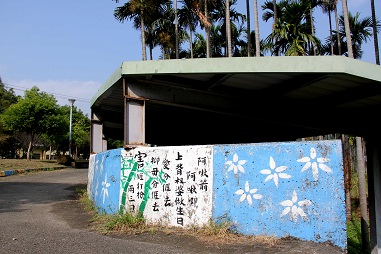
Above: Hakka slang language on the wall
Natural Resource and the Environment
Ruan Qiao lies beneath of the tall mountain, is abundant in environmental resources, including native woods, farmland, the clean Shang Pin Stream and the famous organic vegetables and rice, plus local religious beliefs and the traditional Hakka culture, leisure and tourism resource diversity, all make Ruan Qiao remarkable.
A place at side of the irrigation canal is called Shui Shan Pit was the clothes washing area back to decades ago, women used a wooden bar to beat to clean the clothes. Nowadays, still some women do the laundry here instead of by using the washer at home.
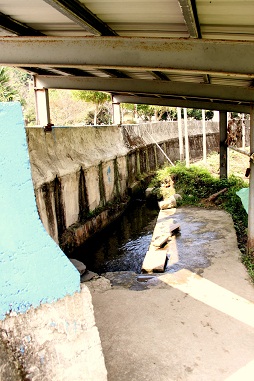
Above: the place for washing clothes
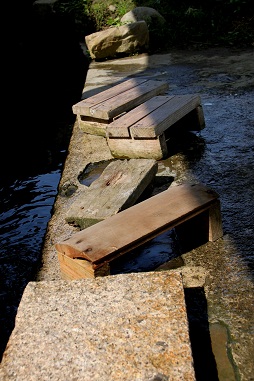
Above: lovely stools that women sit on for washing clothes
And yes, the canales for agriculture, leaded from Zhudong Canal go through this village also make this village important. Water from Shang Pin Stream is utilized to build up the Gui Shan Power Plant. This water source is also the wellhead of the important Bao Shan Reservoir which is the water supply for the famous Hsinchu Science Park. Zhudong Canal was developed during Japanese colonization.
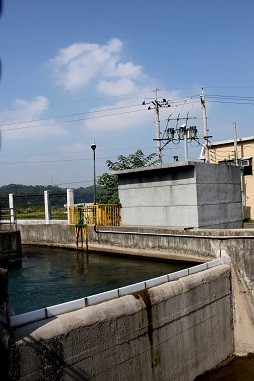 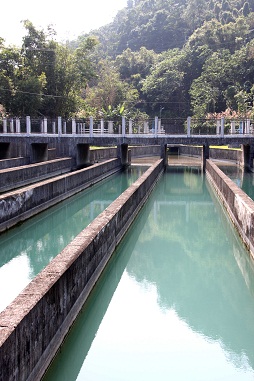
Above: sluice
Community Empowerment by Doing Organic and Canal Dredging
Taking this natural advantage, Ruan Qiao also developed its organic agriculture. For that this area is designed to be the water preservation, no pesticide is allowed, thus the land is well protected and inspected to be of non-toxic. “I’m very proud of the team developing organic rice. Ruan Qiao obtained the 1st prize in Taiwan as early as in 2004.” said S. J..
Another achievement in community empowerment is the “one stone two birds” wisdom, S. J. watched the variegated carp swimming freely in the canal with beautiful smiles. The village donate money for raising fish in the canal, there had no minimum amount, could be as little as NT$10, 30 or 50. This project started from dredging the mud from the canal, breeding the colorful variegated carp all by local residents. This became a village-wide activity that residents collaborate to maintain the cleanliness of the canal, protect the environment as well as take good care of the fishes in the water. The health of variegated carp is the index monitoring the quality of the water. S. J. said, “We cleaned the water and beautify the environment simutaneously.”
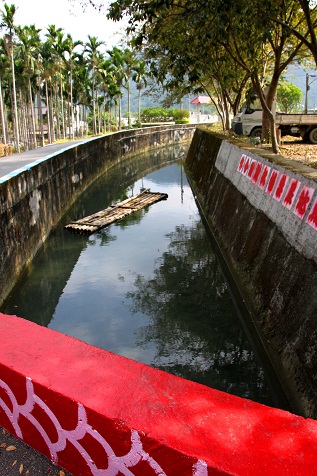
Above: the canal after dredging
The Achievement in Community Empowerment
S. J. said Ruan Qiao has an alias called “The Hidden Rainbow Village” because of the colorful painting in this small village, is regarded as a good reputation that residents are happy with it. The paintings bring in good sense of aesthetics, residents are satisfied with the remarkable result that more and more people know about Ruan Qiao.
Also, for doing organic business, people in Ruan Qiao protect their environment all together. They think and act by themselves, what we can see in Ruan Qiao are the spontaneity, pride and togetherness, making Ruan Qiao their new hometown.
If you are coming to visit this village, I bet you would love it and find it is so attractive not only because of its nature beauty but also the hospitality they welcome you with their pure smiling and the enthusiastic in guiding you to see this village. They certainly are proud of themselves.
| 



















